Forest Resilience and Vegetation Dynamics in Southwest Nigeria: Spatiotemporal Analysis and Assessment of Influencing Factors Using Geographical Detectors and Trend Models
Abstract
1. Introduction
2. Materials and Methods
2.1. Study Area
2.2. Datasets
2.3. Methodology
2.3.1. MVC Technique and Annual Variation for NDVI Enhancement
2.3.2. Sen’s Slope and Mann–Kendall Test
2.3.3. Geographic Detector
3. Results
3.1. Temporal and Spatial Variation in NDVI
3.2. Variation Trends of NDVI
3.3. NDVI Influencing Factors
4. Discussion
4.1. Variation Trend Analysis
4.2. Analysis of Influencing Factors
5. Conclusions
Author Contributions
Funding
Data Availability Statement
Acknowledgments
Conflicts of Interest
Appendix A
References
- Kong, D.; Zhang, Q.; Singh, V.P.; Shi, P. Seasonal vegetation response to climate change in the Northern Hemisphere (1982–2013). Glob. Planet. Change 2017, 148, 1–8. [Google Scholar] [CrossRef]
- Liang, L.; Huang, T.; Di, L.; Geng, D.; Yan, J.; Wang, S.; Wang, L.; Li, L.; Chen, B.; Kang, J. Influence of different bandwidths on LAI estimation using vegetation indices. IEEE J. Sel. Top. Appl. Earth Obs. Remote Sens. 2020, 13, 1494–1502. [Google Scholar] [CrossRef]
- Chen, Y.; Yang, J.; Yu, W.; Ren, J.; Xiao, X.; Xia, J.C. Relationship between urban spatial form and seasonal land surface temperature under different grid scales. Sustain. Cities Soc. 2023, 89, 104374. [Google Scholar] [CrossRef]
- Zhang, Y.; Zhu, Z.; Liu, Z.; Zeng, Z.; Ciais, P.; Huang, M.; Liu, Y.; Piao, S. Seasonal and interannual changes in vegetation activity of tropical forests in Southeast Asia. Agric. For. Meteorol. 2016, 224, 1–10. [Google Scholar] [CrossRef]
- Wang, Y.-F.; Jing, J.-L. Spatial-temporal variations of vegetation cover and its response to climate factors in Guangxi over the past 15 years. Res. Argric. Mod. 2017, 38, 1086–1096. [Google Scholar]
- Chen, T.; Xia, J.; Zou, L.; Hong, S. Quantifying the influences of natural factors and human activities on NDVI changes in the Hanjiang River Basin, China. Remote Sens. 2020, 12, 3780. [Google Scholar] [CrossRef]
- Xu, Z.; Cao, L.; Zhong, S.; Liu, G.; Yang, Y.; Zhu, S.; Luo, X.; Di, L. Trends in global vegetative drought from long-term satellite remote sensing data. IEEE J. Sel. Top. Appl. Earth Obs. Remote Sens. 2020, 13, 815–826. [Google Scholar] [CrossRef]
- Jin, K.; Wang, F.; Li, P. Responses of vegetation cover to environmental change in large cities of China. Sustainability 2018, 10, 270. [Google Scholar] [CrossRef]
- Cheng, F.; Liu, S.; Yin, Y.; Lü, Y.; An, N.; Liu, X. The dynamics and main driving factors of coastal vegetation in Guangxi based on MODIS NDVI. Acta Ecol. Sin. 2017, 37, 788–797. [Google Scholar]
- Jin, K.; Wang, F.; Han, J.; Shi, S.; Ding, W. Contribution of climatic change and human activities to vegetation NDVI change over China during 1982–2015. Acta Geogr. Sin 2020, 75, 961–974. [Google Scholar]
- Prăvălie, R.; Sîrodoev, I.; Nita, I.-A.; Patriche, C.; Dumitraşcu, M.; Roşca, B.; Tişcovschi, A.; Bandoc, G.; Săvulescu, I.; Mănoiu, V. NDVI-based ecological dynamics of forest vegetation and its relationship to climate change in Romania during 1987–2018. Ecol. Indic. 2022, 136, 108629. [Google Scholar] [CrossRef]
- Li, M.; Yin, L.; Zhang, Y.; Su, X.; Liu, G.; Wang, X.; Au, Y.; Wu, X. Spatio-temporal dynamics of fractional vegetation coverage based on MODIS-EVI and its driving factors in Southwest China. Acta Ecol. Sin 2021, 41, 1138–1147. [Google Scholar] [CrossRef]
- He, C.; Yan, F.; Wang, Y.; Lu, Q. Spatiotemporal Variation in Vegetation Growth Status and Its Response to Climate in the Three-River Headwaters Region, China. Remote Sens. 2022, 14, 5041. [Google Scholar] [CrossRef]
- Gao, X.; Zhao, D. Impacts of climate change on vegetation phenology over the Great Lakes Region of Central Asia from 1982 to 2014. Sci. Total Environ. 2022, 845, 157227. [Google Scholar] [CrossRef]
- Hu, W.; Wu, X.; Zhang, K. Spatiotemporal change of beneficiary area from wind erosion prevention service in the Ulan Buh Desert in 2008 and 2018. Geogr. Sustain. 2022, 3, 119–128. [Google Scholar] [CrossRef]
- Chen, P.; Pan, H.; Xu, Y.; He, W.; Yao, H. Spatial-Temporal Evolution Characteristics and Driving Force Analysis of NDVI in Hubei Province, China, from 2000 to 2022. Forests 2024, 15, 719. [Google Scholar] [CrossRef]
- Feng, X.; Tian, J.; Wang, Y.; Wu, J.; Liu, J.; Ya, Q.; Li, Z. Spatio-temporal variation and climatic driving factors of vegetation coverage in the Yellow River Basin from 2001 to 2020 based on kNDVI. Forests 2023, 14, 620. [Google Scholar] [CrossRef]
- Merem, E.; Twumasi, Y.; Wesley, J.; Isokpehi, P.; Fageir, S.; Crisler, M.; Romorno, C.; Hines, A.; Ochai, G.; Leggett, S. Analyzing emerging environmental issues in major areas: The case of Lagos in South West Nigeria. Archit. Res. 2018, 8, 19–38. [Google Scholar] [CrossRef]
- Adesina, J.A.; Liu, Y.; Tang, X.; Ren, Y. Assessing the Impact of Geospatial Susceptibility on the Rural Agricultural Landscapes of Village Settlements in Southwestern Nigeria. Land 2024, 13, 1719. [Google Scholar] [CrossRef]
- Wang, H.; Kang, C.; Tian, Z.; Zhang, A.; Cao, Y. Vegetation periodic changes and relationships with climate in Inner Mongolia Based on the VMD method. Ecol. Indic. 2023, 146, 109764. [Google Scholar] [CrossRef]
- Li, M.; Yan, Q.; Li, G.; Yi, M.; Li, J. Spatio-temporal changes of vegetation cover and its influencing factors in northeast China from 2000 to 2021. Remote Sens. 2022, 14, 5720. [Google Scholar] [CrossRef]
- Jia, Z.; Lei, R.; Liu, Y.; Liu, P.; Wang, Z.; Chang, Y.; Wei, W. Spatial–temporal variations and the driving factors of vegetation coverage in the Loess Hilly and Gully Region of China. Forests 2023, 14, 1238. [Google Scholar] [CrossRef]
- Jin, J.; Liu, S.; Wang, L.; Wu, S.; Zhao, W. Fractional Vegetation Cover and Spatiotemporal Variations of PM2.5 Concentrations in the Beijing-Tianjin-Hebei Region of China. Atmosphere 2022, 13, 1850. [Google Scholar] [CrossRef]
- Li, S.; Xu, L.; Jing, Y.; Yin, H.; Li, X.; Guan, X. High-quality vegetation index product generation: A review of NDVI time series reconstruction techniques. Int. J. Appl. Earth Obs. Geoinf. 2021, 105, 102640. [Google Scholar] [CrossRef]
- Reddy, D.S.; Prasad, P.R.C. Prediction of vegetation dynamics using NDVI time series data and LSTM. Model. Earth Syst. Environ. 2018, 4, 409–419. [Google Scholar] [CrossRef]
- Eckert, S.; Hüsler, F.; Liniger, H.; Hodel, E. Trend analysis of MODIS NDVI time series for detecting land degradation and regeneration in Mongolia. J. Arid Environ. 2015, 113, 16–28. [Google Scholar] [CrossRef]
- Detsch, F.; Otte, I.; Appelhans, T.; Hemp, A.; Nauss, T. Seasonal and long-term vegetation dynamics from 1-km GIMMS-based NDVI time series at Mt. Kilimanjaro, Tanzania. Remote Sens. Environ. 2016, 178, 70–83. [Google Scholar] [CrossRef]
- Ning, T.; Liu, W.; Lin, W.; Song, X. NDVI variation and its responses to climate change on the northern Loess Plateau of China from 1998 to 2012. Adv. Meteorol. 2015, 2015, 725427. [Google Scholar] [CrossRef]
- Usman, U.; Yelwa, S.; Gulumbe, S.; Danbaba, A.; Nir, R. Modelling relationship between NDVI and climatic variables using geographically weighted regression. J. Math. Sci. Appl. 2013, 1, 24–28. [Google Scholar]
- Aweda, E.; Adeyewa, Z. Inter annual variation of vegetation anomaly over Nigeria using satellite-derived index. Adv. Appl. Sci. Res. 2011, 2, 468–475. [Google Scholar]
- Schlesinger, W.H.; Jasechko, S. Transpiration in the global water cycle. Agric. For. Meteorol. 2014, 189, 115–117. [Google Scholar] [CrossRef]
- Freeman, A.A.B.; Mensah, I.; Antwi, K.B. Smiling vs. Frowning Faces: Community Participation for Sustainable Tourism in Ghanaian Communities. In Prospects and Challenges of Community-Based Tourism and Changing Demographics; IGI Global: Hershey, PA, USA, 2022; pp. 83–106. [Google Scholar]
- Pendrill, F.; Gardner, T.A.; Meyfroidt, P.; Persson, U.M.; Adams, J.; Azevedo, T.; Bastos Lima, M.G.; Baumann, M.; Curtis, P.G.; De Sy, V. Disentangling the numbers behind agriculture-driven tropical deforestation. Science 2022, 377, eabm9267. [Google Scholar] [CrossRef] [PubMed]
- Tahiru, A.A.; Doke, D.A.; Baatuuwie, B.N. Effect of land use and land cover changes on water quality in the Nawuni Catchment of the White Volta Basin, Northern Region, Ghana. Appl. Water Sci. 2020, 10, 198. [Google Scholar] [CrossRef]
- Ikhuoso, O.A.; Adegbeye, M.; Elghandour, M.; Mellado, M.; Al-Dobaib, S.; Salem, A. Climate change and agriculture: The competition for limited resources amidst crop farmers-livestock herding conflict in Nigeria-A review. J. Clean. Prod. 2020, 272, 123104. [Google Scholar] [CrossRef]
- Teshome, D.T.; Zharare, G.E.; Naidoo, S. The threat of the combined effect of biotic and abiotic stress factors in forestry under a changing climate. Front. Plant Sci. 2020, 11, 601009. [Google Scholar] [CrossRef]
- Fayech, D.; Tarhouni, J. Climate variability and its effect on normalized difference vegetation index (NDVI) using remote sensing in semi-arid area. Model. Earth Syst. Environ. 2021, 7, 1667–1682. [Google Scholar] [CrossRef]
- Hao, J.; Xu, G.; Luo, L.; Zhang, Z.; Yang, H.; Li, H. Quantifying the relative contribution of natural and human factors to vegetation coverage variation in coastal wetlands in China. Catena 2020, 188, 104429. [Google Scholar] [CrossRef]
- Lin, Q.; Wu, Z.; Singh, V.P.; Sadeghi, S.; He, H.; Lu, G. Correlation between hydrological drought, climatic factors, reservoir operation, and vegetation cover in the Xijiang Basin, South China. J. Hydrol. 2017, 549, 512–524. [Google Scholar] [CrossRef]
- Yelwa, S.A.; Sanda, A.B.; Usman, U. Spatio-Temporal Assessment of Vegetation Resource Dynamics in Nigeria from SPOT Satellite Imageries. Am. J. Clim. Change 2019, 8, 502. [Google Scholar] [CrossRef]
- Salam, R.D.; Oluwatimilehin, I.A.; Ayanlade, A. Spatial analysis of urban expansion, land-use dynamics and its effects on land surface temperature in Oyo town, Southwestern Nigeria. City Built Environ. 2023, 1, 15. [Google Scholar] [CrossRef]
- Agbelade, A.D. Analyzing the influence of urban vegetation cover on land surface temperature in Southwestern Nigeria. Discov. Environ. 2025, 3, 10. [Google Scholar] [CrossRef]
- Fashae, O.A.; Adagbasa, E.G.; Olusola, A.O.; Obateru, R.O. Land use/land cover change and land surface temperature of Ibadan and environs, Nigeria. Environ. Monit. Assess. 2020, 192, 109. [Google Scholar] [CrossRef] [PubMed]
- Adedotun, A.F.; Adesina, O.S.; Taiwo, A.I.; Odekina, O.G.; Adedotun, O.A.; Adoghe, V.O. A Non-Parametric Analysis of the Effect of COVID-19 Pandemic on Nigerians’well-Being Based on Geopolitical Zones. JP J. Biostat. 2024, 24, 177–196. [Google Scholar] [CrossRef]
- Olukanni, D.; Aremu, D. Provisional evaluation of composting as priority option for sustainable waste management in South-West Nigeria. Pollution 2017, 3, 417–428. [Google Scholar]
- Oyebode, L.A.; Akinbile, L.A. Processors’ Acquisition of Productive Assets Under National Fadama Development Project III in Southwest, Nigeria. J. Agric. Ext. 2023, 28, 37–45. [Google Scholar] [CrossRef]
- Nwoko, K.C.; Osiki, O.M. From the Hub of Lagos: Horizontal integration for the Southwest region of Nigeria, a developmental imperative. Afr. Zamani 2016, 24, 111–128. [Google Scholar]
- Ejaro, S.P.; Abubakar, A. The challenges of rapid urbanization on sustainable development of Nyanya, Federal Capital Territory, Abuja, Nigeria. J. Appl. Sci. Environ. Manag. 2013, 17, 299–313. [Google Scholar] [CrossRef]
- Zabbey, N.; Giadom, F.D.; Babatunde, B.B. Nigerian coastal environments. In World Seas: An Environmental Evaluation; Elsevier: Amsterdam, The Netherlands, 2019; pp. 835–854. [Google Scholar]
- Aghimien, E.; Akinkuoroye, O.; Fakolade, A. Assessment of Waste Associated with Timber Flitching in Bodija Plank Market, Ibadan, Nigeria. In Climate Smart Agriculture and Agribusiness Development in Nigeria; The Alex Ekwueme Federal University Ndufu-Alike: Abakaliki, Nigeria, 2021; Volume 113. [Google Scholar]
- Bajgain, R.; Xiao, X.; Wagle, P.; Basara, J.; Zhou, Y. Sensitivity analysis of vegetation indices to drought over two tallgrass prairie sites. ISPRS J. Photogramm. Remote Sens. 2015, 108, 151–160. [Google Scholar] [CrossRef]
- Goovaerts, P. Geostatistical approaches for incorporating elevation into the spatial interpolation of rainfall. J. Hydrol. 2000, 228, 113–129. [Google Scholar] [CrossRef]
- Lloyd, C. Assessing the effect of integrating elevation data into the estimation of monthly precipitation in Great Britain. J. Hydrol. 2005, 308, 128–150. [Google Scholar] [CrossRef]
- Prasannakumar, V.; Shiny, R.; Geetha, N.; Vijith, H. Applicability of SRTM data for landform characterisation and geomorphometry: A comparison with contour-derived parameters. Int. J. Digit. Earth 2011, 4, 387–401. [Google Scholar] [CrossRef]
- Yue, L.; Shen, H.; Zhang, L.; Zheng, X.; Zhang, F.; Yuan, Q. High-quality seamless DEM generation blending SRTM-1, ASTER GDEM v2 and ICESat/GLAS observations. ISPRS J. Photogramm. Remote Sens. 2017, 123, 20–34. [Google Scholar] [CrossRef]
- Yang, L.; Meng, X.; Zhang, X. SRTM DEM and its application advances. Int. J. Remote Sens. 2011, 32, 3875–3896. [Google Scholar] [CrossRef]
- Fan, X.; Liu, Y.; Wu, G.; Zhao, X. Compositing the minimum NDVI for daily water surface mapping. Remote Sens. 2020, 12, 700. [Google Scholar] [CrossRef]
- Nfornkah, B.N.; Rene, K.; Martin, T.; Louis, Z.; Cedric, C.; Armand, T. Assessing the spatial distribution of bamboo species using remote sensing in Cameroon. J. Ecol. Nat. Environ. 2020, 12, 172–183. [Google Scholar]
- Wen, Z.; Wu, S.; Chen, J.; Lü, M. NDVI indicated long-term interannual changes in vegetation activities and their responses to climatic and anthropogenic factors in the Three Gorges Reservoir Region, China. Sci. Total Environ. 2017, 574, 947–959. [Google Scholar] [CrossRef]
- Zhong, X.; Li, J.; Wang, J.; Zhang, J.; Liu, L.; Ma, J. Linear and nonlinear characteristics of long-term NDVI using trend analysis: A case study of Lancang-Mekong River Basin. Remote Sens. 2022, 14, 6271. [Google Scholar] [CrossRef]
- Liu, H.; Zheng, H.; Wu, L.; Deng, Y.; Chen, J.; Zhang, J. Spatiotemporal Evolution in the Thermal Environment and Impact Analysis of Drivers in the Beijing–Tianjin–Hebei Urban Agglomeration of China from 2000 to 2020. Remote Sens. 2024, 16, 2601. [Google Scholar] [CrossRef]
- Geng, S.; Zhang, H.; Xie, F.; Li, L.; Yang, L. Vegetation Dynamics Under Rapid Urbanization in the Guangdong–Hong Kong–Macao Greater Bay Area Urban Agglomeration During the Past Two Decades. Remote Sens. 2022, 14, 3993. [Google Scholar] [CrossRef]
- Zhang, Y.; Zhao, Z.; Fu, B.; Ma, R.; Yang, Y.; Lü, Y.; Wu, X. Identifying ecological security patterns based on the supply, demand and sensitivity of ecosystem service: A case study in the Yellow River Basin, China. J. Environ. Manag. 2022, 315, 115158. [Google Scholar] [CrossRef]
- Song, Y.; Wang, J.; Ge, Y.; Xu, C. An optimal parameters-based geographical detector model enhances geographic characteristics of explanatory variables for spatial heterogeneity analysis: Cases with different types of spatial data. GIScience Remote Sens. 2020, 57, 593–610. [Google Scholar] [CrossRef]
- Wang, W.; Yang, Y. Spatial-temporal differentiation characteristics and driving factors of China’s energy eco-efficiency based on geographical detector model. J. Clean. Prod. 2024, 434, 140153. [Google Scholar] [CrossRef]
- Onilude, O.O.; Vaz, E. Data analysis of land use change and urban and rural impacts in Lagos state, Nigeria. Data 2020, 5, 72. [Google Scholar] [CrossRef]
- Obiefuna, J.N.; Okolie, C.J.; Atagbaza, A.O.; Nwilo, P.C.; Akindeju, F.O. Spatio-temporal land cover dynamics and emerging landscape patterns in western part of Lagos State, Nigeria. Environ. Socio-Econ. Stud. 2021, 9, 53–69. [Google Scholar] [CrossRef]
- Fasona, M.J.; Akintuyi, A.O.; Adeonipekun, P.A.; Akoso, T.M.; Udofia, S.K.; Agboola, O.O.; Ogunsanwo, G.E.; Ariori, A.N.; Omojola, A.S.; Soneye, A.S. Recent trends in land-use and cover change and deforestation in south–west Nigeria. GeoJournal 2022, 87, 1411–1437. [Google Scholar] [CrossRef]
- Ologunde, O.H.; Kelani, M.O.; Biru, M.K.; Olayemi, A.B.; Nunes, M.R. Land Use and Land Cover Changes: A Case Study in Nigeria. Land 2025, 14, 389. [Google Scholar] [CrossRef]
- Akintuyi, A.O.; Fasona, M.J.; Ayeni, A.O.; Soneye, A.S. Land use/land cover and climate change interaction in the derived savannah region of Nigeria. Environ. Monit. Assess. 2021, 193, 848. [Google Scholar] [CrossRef]
- Usman, M.; Nichol, J.E. Changes in agricultural and grazing land, and insights for mitigating farmer-herder conflict in West Africa. Landsc. Urban Plan. 2022, 222, 104383. [Google Scholar] [CrossRef]
- Fasona, M.; Akintuyi, A.; Udofia, S.; Akoso, T.; Ariori, N.; Adeonipekun, P.; Agboola, O.; Ogundipe, O.; Soneye, A.; Omojola, A. Deforestation and Land-Cover Changes in the Forest Reserves of Southwest Nigeria; Department of Geography, Univesrity of Lagos: Lagos, Nigeria, 2018. [Google Scholar]
- Akinbobola, A.; Fafure, T. Assessing the Impact of Urbanization on Outdoor Thermal Comfort in Selected Local Government Areas in Ogun State, Nigeria. Niger. J. Environ. Sci. Technol. (NIJEST) 2021, 5, 120–139. [Google Scholar] [CrossRef]
- Abiodun, O.; Salami, T. Land Use Dynamics of Urban Change in the Lagos-Ogun Urban Fringe, Southwest Nigeria. Urban Reg. Plan. Rev. 2023, 9, 78–88. [Google Scholar]
- Potapov, P.; Tyukavina, A.; Turubanova, S.; Talero, Y.; Hernandez-Serna, A.; Hansen, M.; Saah, D.; Tenneson, K.; Poortinga, A.; Aekakkararungroj, A. Annual continuous fields of woody vegetation structure in the Lower Mekong region from 2000–2017 Landsat time-series. Remote Sens. Environ. 2019, 232, 111278. [Google Scholar] [CrossRef]
- Cai, Y.; Zhang, F.; Duan, P.; Jim, C.Y.; Chan, N.W.; Shi, J.; Liu, C.; Wang, J.; Bahtebay, J.; Ma, X. Vegetation cover changes in China induced by ecological restoration-protection projects and land-use changes from 2000 to 2020. Catena 2022, 217, 106530. [Google Scholar] [CrossRef]
- Kemarau, R.A.; Eboy, O.V. Land Cover Change Detection in Kuching, Malaysia Using Satellite Imagery. Borneo J. Sci. Technol. 2021, 3, 61–65. [Google Scholar]
- Yang, S.; Song, S.; Li, F.; Yu, M.; Yu, G.; Zhang, Q.; Cui, H.; Wang, R.; Wu, Y. Vegetation coverage changes driven by a combination of climate change and human activities in Ethiopia, 2003–2018. Ecol. Inform. 2022, 71, 101776. [Google Scholar] [CrossRef]
- Fornacca, D.; Ren, G.; Xiao, W. Performance of three MODIS fire products (MCD45A1, MCD64A1, MCD14ML), and ESA Fire_CCI in a mountainous area of Northwest Yunnan, China, characterized by frequent small fires. Remote Sens. 2017, 9, 1131. [Google Scholar] [CrossRef]
- Zhang, H.; Zha, T.; Yu, Y.; Zhang, Z.; Zhang, X.; Zhang, H.; Ji, X. Functional vegetation community responses to soil and topographic factors in the Loess Plateau of China. Land Degrad. Dev. 2023, 34, 5355–5372. [Google Scholar] [CrossRef]
- Afuye, G.; Kalumba, A.; Orimoloye, I. Characterisation of Vegetation Response to Climate Change: A Review. Sustainability 2021, 13, 7265. [Google Scholar] [CrossRef]
- Olorunfemi, I.E.; Fasinmirin, J.T.; Olufayo, A.A.; Komolafe, A.A. GIS and remote sensing-based analysis of the impacts of land use/land cover change (LULCC) on the environmental sustainability of Ekiti State, southwestern Nigeria. Environ. Dev. Sustain. 2020, 22, 661–692. [Google Scholar] [CrossRef]
- Anthony, T.; Shohan, A.A.A.; Oludare, A.; Alsulamy, S.; Kafy, A.-A.; Khedher, K.M. Spatial analysis of land cover changes for detecting environmental degradation and promoting sustainability. Kuwait J. Sci. 2024, 51, 100197. [Google Scholar] [CrossRef]
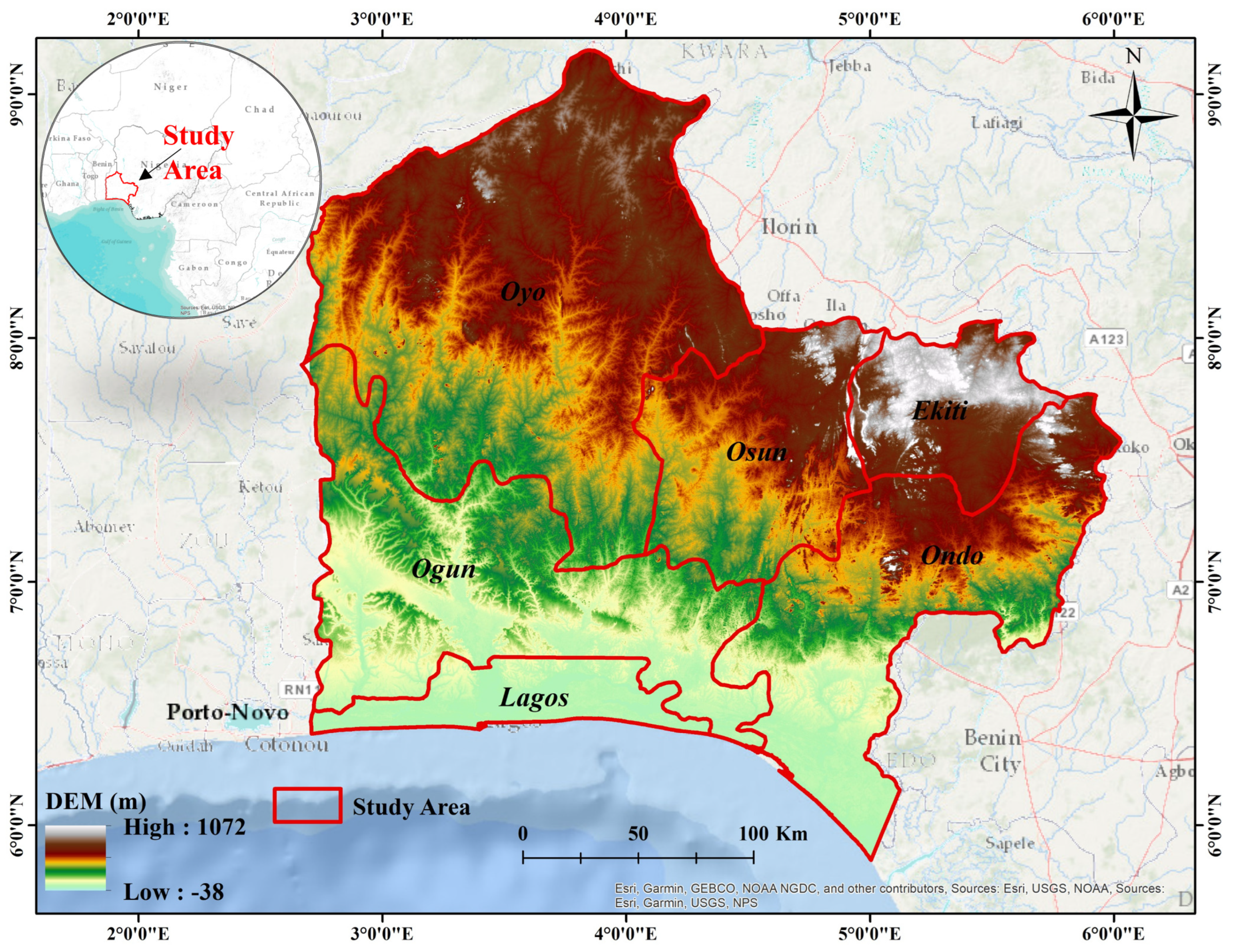


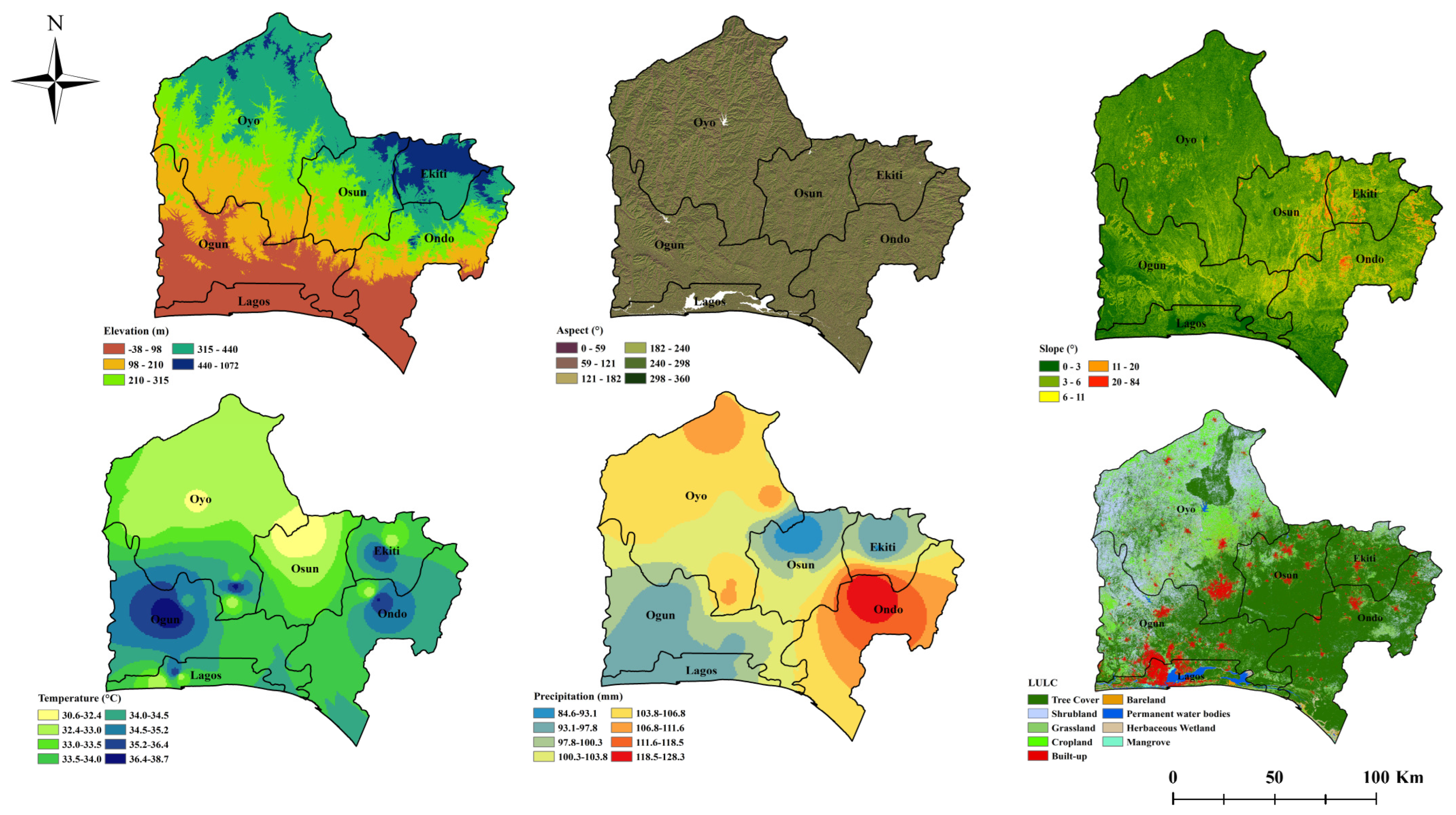
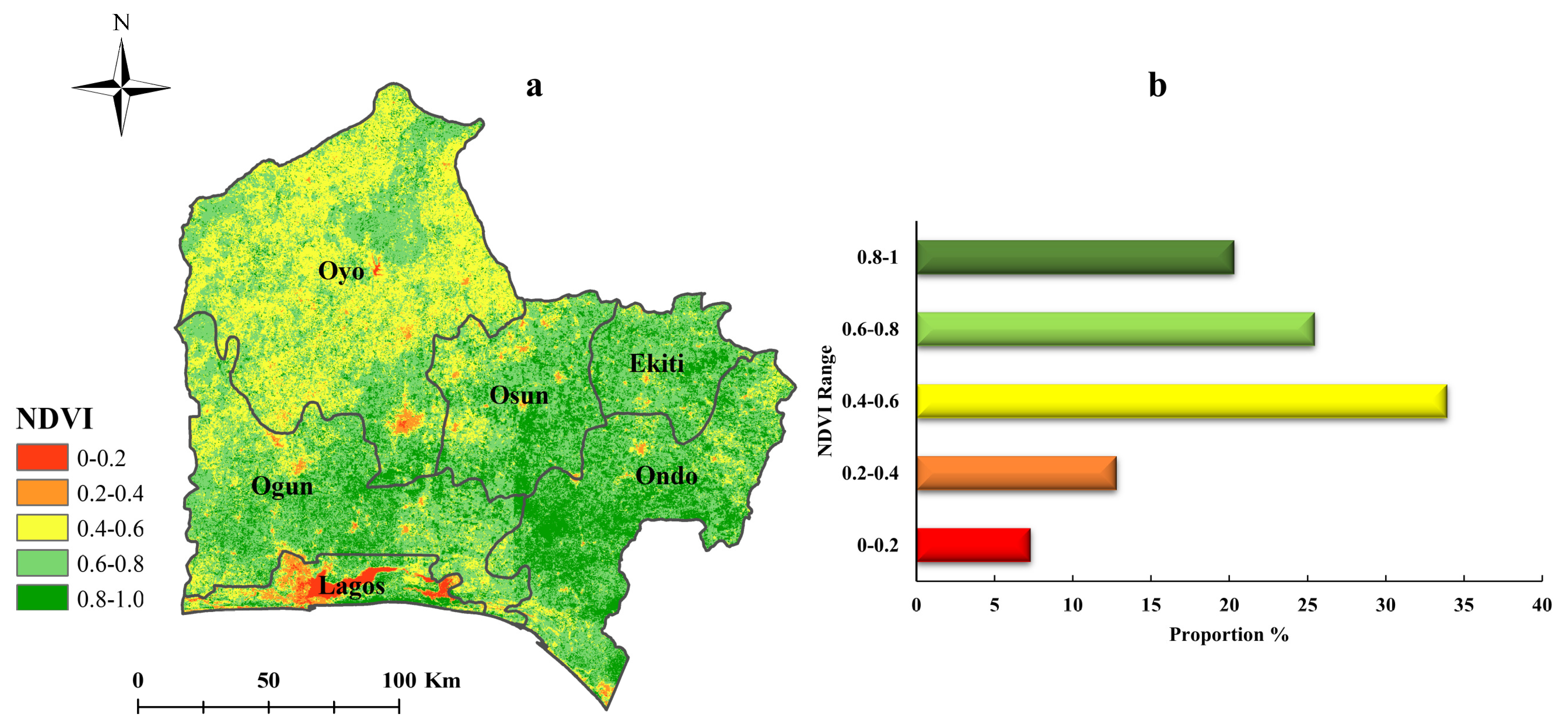
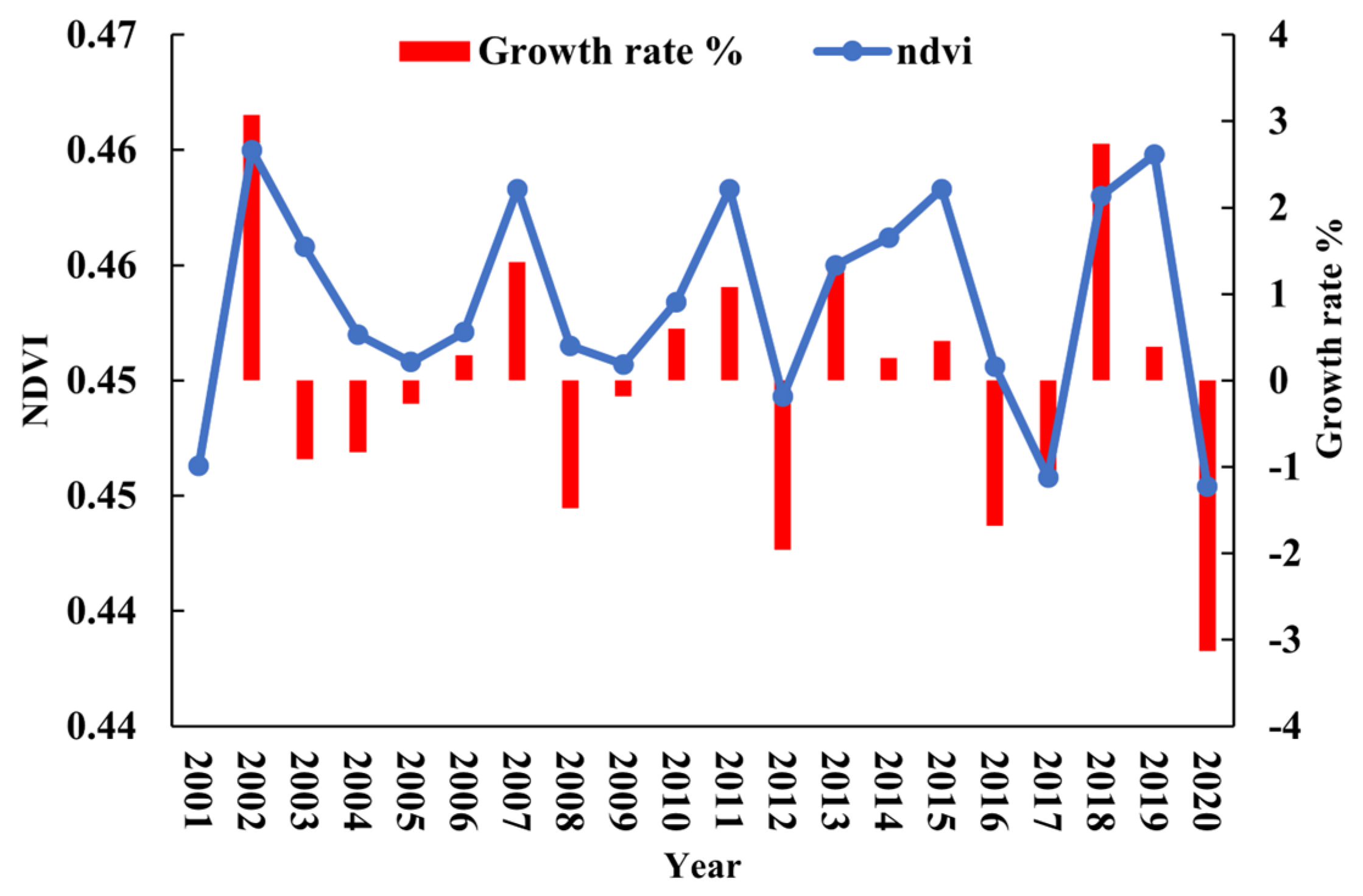

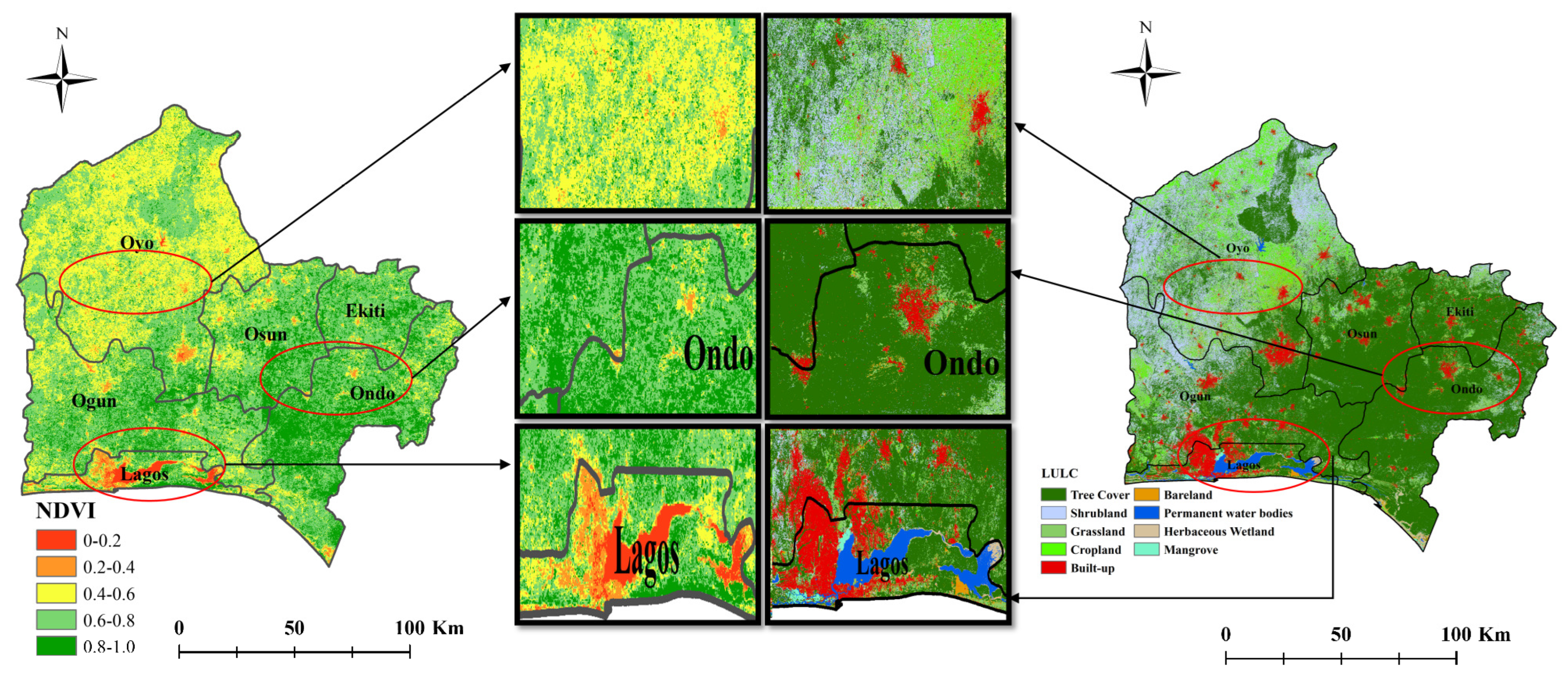
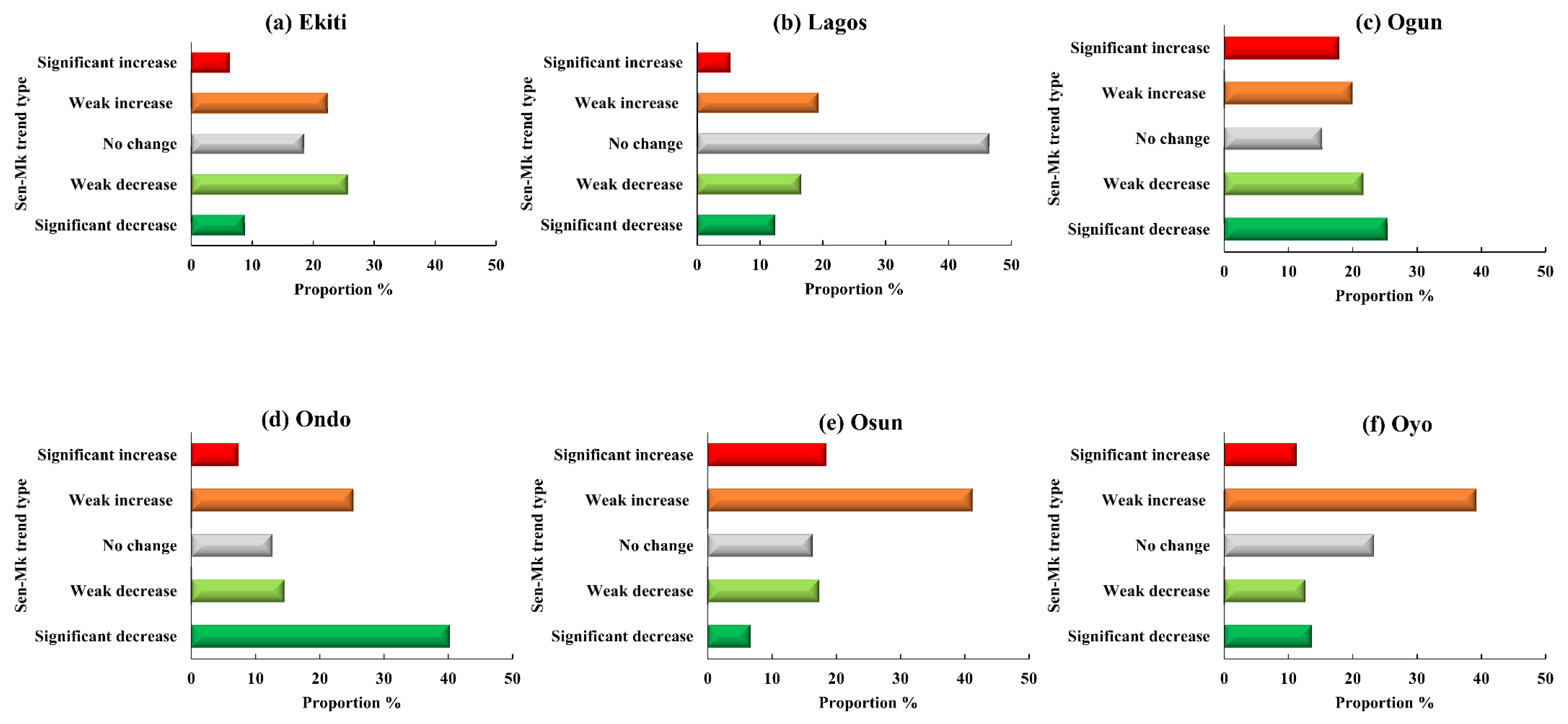
| Factor Category | Factor | Resolution | Origin/URL |
|---|---|---|---|
| Vegetation Index | NDVI | 250 m | Google Earth Engine (https://earthengine.google.com/) USGS (https://lpdaac.usgs.gov/products/) |
| Topography | Elevation | 90 m | Google Earth Engine (https://earthengine.google.com/) NASA (https://opentopography.org/) |
| Slope | 90 m | ||
| Aspect | 90 m | ||
| Climate | Temperature | 250 m | NIMET (https://nimet.gov.ng/) |
| Precipitation | 250 m | ||
| Human variable | LULC | 10 m | Google Earth Engine (https://earthengine.google.com/) ESA (https://esa-worldcover.org/en) |
| Administrative division | 1:1,000,000 | http://www.nasrda.gov.ng/ (accessed on 26 May 2024) |
| Z Value | Sen-MK Type | |
|---|---|---|
| 0.0005) | Significant (Z < −1.96) | Significant decrease |
| 0.0005) | Insignificant (−1.96 < Z < 1.96) | Weak decrease |
| 0.0005) | Insignificant (−1.96 < Z < 1.96) | No change |
| 0.0005) | Insignificant (−1.96 < Z < 1.96) | Weak increase |
| 0.0005) | Significant (Z ≥ 1.96) | Significant increase |
| Description | Connection |
|---|---|
| )] | Nonlinearity attenuation |
| )] | The single-factor nonlinearity decreases |
| )] | Two-factor enhancement |
| ) | Independent |
| ) | Nonlinear enhancement |
| Factor | Symbol | Method | Category |
|---|---|---|---|
| NDVI | - | ||
| Elevation | Natural break | 5 | |
| Slope | Manual | 5 | |
| Aspect | Manual | 6 | |
| Temperature | Equal interval | 8 | |
| Precipitation | Equal interval | 8 | |
| LULC | Manual | 9 |
| State | Initiative | Influencing Factors | |||||
|---|---|---|---|---|---|---|---|
| Elevation | Slope | Aspect | Temperature | Precipitation | LULC | ||
| SWR | q value | 0.2743 | 0.3413 | 0.0321 | 0.1467 | 0.2141 | 0.4428 |
| Ekiti | 0.3008 | 0.3321 | 0.0246 | 0.0321 | 0.1432 | 0.4211 | |
| Lagos | 0.1432 | 0.3673 | 0.0051 | 0.1253 | 0.3242 | 0.5234 | |
| Ogun | 0.3225 | 0.3960 | 0.0051 | 0.0924 | 0.2641 | 0.4832 | |
| Ondo | 0.3679 | 0.3217 | 0.0331 | 0.1026 | 0.1080 | 0.4641 | |
| Osun | 0.2458 | 0.3072 | 0.0247 | 1.2351 | 0.1263 | 0.3735 | |
| Oyo | 0.2692 | 0.2410 | 0.0228 | 1.6481 | 0.0241 | 0.4692 | |
| Elevation | Slope | Aspect | Temperature | Precipitation | LULC | |
|---|---|---|---|---|---|---|
| Elevation | 0.2341 | |||||
| Slope | 0.3145 | 0.2562 | ||||
| Aspect | 0.2341 | 0.2632 | 0.0321 | |||
| Temperature | 0.2351 | 0.2779 | 0.1842 | 0.1432 | ||
| Precipitation | 0.3341 | 0.3122 | 0.156 | 0.243 | 0.1325 | |
| LULC | 0.4531 | 0.4762 | 0.4013 | 0.4432 | 0.4721 | 0.4231 |
Disclaimer/Publisher’s Note: The statements, opinions and data contained in all publications are solely those of the individual author(s) and contributor(s) and not of MDPI and/or the editor(s). MDPI and/or the editor(s) disclaim responsibility for any injury to people or property resulting from any ideas, methods, instructions or products referred to in the content. |
© 2025 by the authors. Licensee MDPI, Basel, Switzerland. This article is an open access article distributed under the terms and conditions of the Creative Commons Attribution (CC BY) license (https://creativecommons.org/licenses/by/4.0/).
Share and Cite
Adelabu, I.; Wang, L. Forest Resilience and Vegetation Dynamics in Southwest Nigeria: Spatiotemporal Analysis and Assessment of Influencing Factors Using Geographical Detectors and Trend Models. Forests 2025, 16, 811. https://doi.org/10.3390/f16050811
Adelabu I, Wang L. Forest Resilience and Vegetation Dynamics in Southwest Nigeria: Spatiotemporal Analysis and Assessment of Influencing Factors Using Geographical Detectors and Trend Models. Forests. 2025; 16(5):811. https://doi.org/10.3390/f16050811
Chicago/Turabian StyleAdelabu, Ismail, and Lihong Wang. 2025. "Forest Resilience and Vegetation Dynamics in Southwest Nigeria: Spatiotemporal Analysis and Assessment of Influencing Factors Using Geographical Detectors and Trend Models" Forests 16, no. 5: 811. https://doi.org/10.3390/f16050811
APA StyleAdelabu, I., & Wang, L. (2025). Forest Resilience and Vegetation Dynamics in Southwest Nigeria: Spatiotemporal Analysis and Assessment of Influencing Factors Using Geographical Detectors and Trend Models. Forests, 16(5), 811. https://doi.org/10.3390/f16050811




